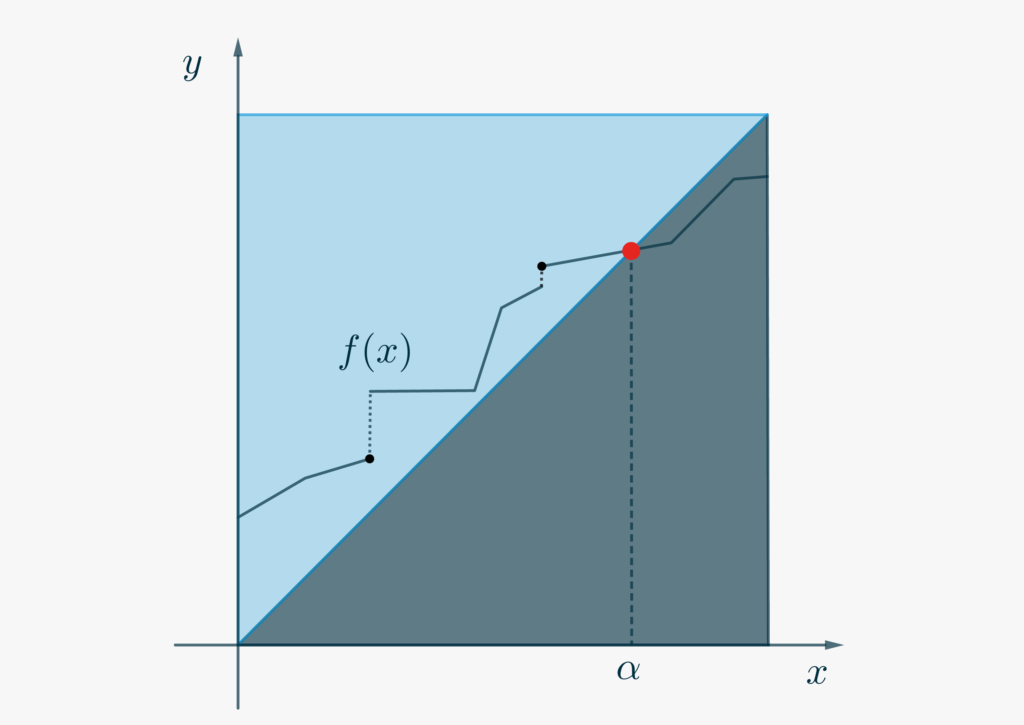The concepts of monotonicity and continuity are very different. However, if we consider a monotonic function whose domain is an interval, we can deduce that right and left limits exist at each point in the domain (even though they may be different, of course). This is a consequence of the Completeness principle, which implies that every upper (lower) bounded set has a supremum (infimum).
We can therefore demonstrate a Theorem which is somehow close to the Intermediate Value Theorem, albeit “weaker”.
Theorem. Let \(f: [0,1] \to [0,1]\) a monotonically increasing function. Then there exists a point \(\alpha \in [0,1]\) such that \(f(\alpha) = \alpha\).

The proof, too, follows the same approach that can be used to demonstrate the I.V.T.
If \(f(0) = 0\) or \(f(1) = 1\), then we have found \(\alpha\). Conversely we can define a procedure that either will stop once the required point is found, or will allow us to construct two sequences converging to it. Here’s how.
Let \(a_0=0\) and \(b_0=1\). Then for \(n=1,2,3,\dots\) proceed as follows.
- Determine \(x_n = \frac{a_{n-1}+b_{n-1}}{2}\);
- If \(f(x_n) = x_n\) then \(\alpha = x_n\) and we are done;
- If \(f(x_n) > x_n\) then let \(a_n = x_n\) and \(b_n = b_{n-1}\);
- If \(f(x_n) < x_n\) then let \(a_n = a_{n-1}\) and \(b_n = x_n\).
Let us verify that if the search does not stop, then the sequences \((a_n)\) and \((b_n)\) converge to the desired value. First of all, the sequences do converge, since they are monotonic and bounded (here Completeness comes into play). Secondarily, since
\[a_n-b_n = \frac{1}{2^n},\]
they converge to the same value, say \(\overline x\).
Furthermore we have
\begin{equation}f(a_n)>a_n\tag{1}\label{eq656:a}\end{equation}
and
\begin{equation}f(b_n)< b_n\tag{2}\label{eq656:b}\end{equation}
for all \(n\).
Suppose now \(f(\overline{x}) < \overline x\). Then, because \((a_n)\) converges to \(\overline x\), for large enough \(n\) we should have
\[f(\overline x) < a_n < \overline x,\]
But, this, together with equation \eqref{eq656:a} gives \(f(a_n) > f(\overline x)\), contradicting monotonicity of \(f\). Analogously, if we assume \(f(\overline{x}) > \overline x\), then we get, for large enough \(n\),
\[\overline x < b_n < f(\overline x),\]
yielding, together with \eqref{eq656:b}, \(f(b_n) < f(\overline x)\), i.e. again a contradiction. Thus it must be \(f(\overline x) = \overline x\) and \(\overline x = \alpha\).
It shoud be observed that Completeness is in fact necessary for the Theorem to hold. As a counterexample consider the function \(f: [0,1]\cap \Bbb Q \to [0,1]\cap \Bbb Q\) defined as
\[f(x) = \frac{1}{3-x},\]
which is monotonic and even continuous in its domain. However there is no \(\alpha\) such that
\[\frac{1}{3-\alpha} = \alpha,\]
because then \(\alpha\) would be a solution to the quadratic equation
\[\alpha^2-3\alpha + 1=0\]
which we know does not have solutions in \(\Bbb Q\).
As a final exercise you can try to demonstrate again the Theorem after replacing “monotonically increasing” with “continuous” in the hypothesis. (Hint: consider using the auxiliary function \(F(x) = f(x)-x\).)
